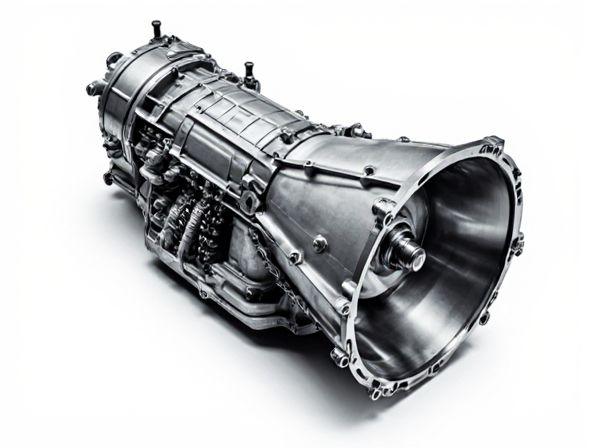
Photo illustration: Overdrive gear vs Direct drive
Overdrive gear increases engine efficiency by allowing your vehicle to maintain highway speeds at lower RPMs, reducing fuel consumption and engine wear. Direct drive provides a one-to-one ratio between the engine and transmission, offering better power transfer and responsiveness at the cost of higher fuel usage. Choosing between overdrive and direct drive depends on your driving needs, such as fuel economy versus performance.
Table of Comparison
| Feature | Overdrive Gear | Direct Drive |
|---|---|---|
| Gear Ratio | Less than 1:1 (e.g., 0.7:1) | Equal to 1:1 |
| Fuel Efficiency | Improves at high speeds | Moderate, consistent power delivery |
| Engine RPM | Lower RPM at cruising speed | Higher RPM, same as output shaft |
| Use Case | Highway cruising, fuel saving | City driving, towing, acceleration |
| Power Transfer | Reduced engine load, less torque | Direct engine-to-wheels power |
| Heat Generation | Lower heat, efficient operation | Higher heat due to direct torque transfer |
Understanding Overdrive Gear and Direct Drive
Overdrive gear systems increase a vehicle's engine efficiency by allowing the output shaft to rotate faster than the input shaft, reducing engine RPM at highway speeds and improving fuel economy. Direct drive transmits power from the engine to the wheels without gear reduction, offering a more straightforward and efficient power transfer with minimal energy loss. Understanding the distinct mechanical advantages of overdrive gear and direct drive helps optimize vehicle performance based on driving conditions and efficiency goals.
Key Differences Between Overdrive and Direct Drive
Overdrive gear systems increase the output speed relative to the input speed, enhancing fuel efficiency and reducing engine RPM at highway speeds, while direct drive gears maintain a 1:1 ratio for greater torque transmission and simplicity. Overdrive units typically involve added gearing mechanisms that can introduce slight mechanical complexity and potential power loss, whereas direct drive systems offer a more straightforward, reliable transfer of power. The choice between overdrive and direct drive depends on factors such as desired fuel economy, performance requirements, and mechanical design preferences.
How Overdrive Gear Works
Overdrive gear functions by increasing the output speed of the transmission beyond the input speed, effectively reducing engine RPM for a given road speed and enhancing fuel efficiency. It achieves this through a gear set with an output gear larger than the input gear, allowing the vehicle to maintain cruising speeds with less engine strain and noise. This mechanism contrasts with direct drive, where input and output gears rotate at the same speed, offering less fuel economy at high speeds.
How Direct Drive Functions
Direct drive functions by connecting the motor shaft directly to the wheel or pulley without intermediary gears, delivering instantaneous power transfer and superior torque precision. This system reduces mechanical losses and wear, enhancing durability and responsiveness compared to overdrive gear setups that rely on multiple gear stages. The direct coupling allows for quieter operation and increased efficiency in applications such as industrial machinery and electric vehicles.
Performance Impact: Overdrive vs Direct Drive
Overdrive gears increase output speed by rotating faster than the input shaft, enhancing top speed but potentially reducing torque and increasing drivetrain stress. Direct drive systems transmit power without speed alteration, offering higher torque efficiency and immediate responsiveness, which improves acceleration and control. Performance impact favors overdrive for high-speed applications, while direct drive excels in torque-demanding scenarios requiring precise power delivery.
Fuel Efficiency Comparison
Overdrive gear in vehicles reduces engine RPM at higher speeds, leading to lower fuel consumption compared to direct drive systems that maintain a 1:1 ratio, resulting in higher RPM and increased fuel usage. Direct drive offers better power transmission efficiency but sacrifices fuel economy, especially during highway cruising where overdrive significantly optimizes fuel efficiency by minimizing engine load. Choosing overdrive gear can improve miles per gallon (MPG) by approximately 10-15% in typical driving conditions versus traditional direct drive setups.
Pros and Cons of Overdrive Gear
Overdrive gear systems offer improved fuel efficiency and reduced engine wear by lowering RPMs at cruising speeds, making them ideal for long-distance driving. However, they tend to generate more heat and may cause increased transmission complexity and maintenance compared to direct drive systems. Direct drive provides a more robust and efficient power transfer at the cost of higher engine RPM during highway travel.
Pros and Cons of Direct Drive
Direct drive systems deliver superior torque and precise power transfer, making them ideal for high-performance applications and professional use. Their direct connection reduces drivetrain loss and enhances responsiveness but typically results in heavier and more expensive equipment compared to overdrive gear systems. Maintenance can be simpler due to fewer moving parts, although initial costs and weight may deter casual users.
Applications: When to Use Overdrive or Direct Drive
Overdrive gear systems are ideal for applications that require higher speed outputs with lower torque, such as automotive transmissions designed for fuel efficiency at highway speeds. Direct drive mechanisms excel in scenarios demanding precise control and high torque at lower speeds, commonly employed in industrial machinery and electric vehicles for enhanced power delivery and reduced mechanical complexity. Choosing between overdrive and direct drive depends on the need for speed optimization or torque precision in the specific application.
Choosing the Right Drive System for Your Vehicle
Overdrive gear systems improve fuel efficiency by reducing engine RPM at higher speeds, making them ideal for highway driving and vehicles prioritizing fuel economy. Direct drive systems provide a 1:1 gear ratio, enhancing power transfer and responsiveness, which benefits performance-oriented vehicles and heavy-duty applications. Choosing the right drive system depends on your vehicle's primary use--opt for overdrive for fuel savings and smooth cruising, or direct drive for maximum power and control.
 caratoz.com
caratoz.com